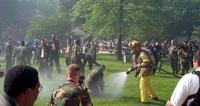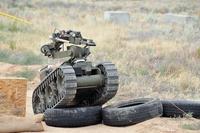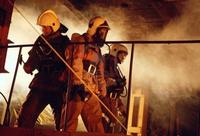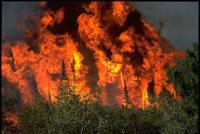-
New firefighter breathing equipment test goes into effect 1 September
As of 1 September 2013, standard firefighter breathing equipment cannot be certified to National Fire Protection Association (NFPA) standards unless the facepiece lenses pass a new rigorous test developed by the National Institute of Standards and Technology (NIST).
-
-
Responding to international WMD incidents

Experts taking part in a workshop discussed ways to improve the U.S. government’s assistance in responding to a chemical, biological, radiological, or nuclear incident that might occur elsewhere in the world. In addition to preventing and alleviating human suffering, reducing the impacts of these incidents through better response could decrease the attractiveness to terrorists of causing such incidents.
-
-
Sandia hosts annual Robot Rodeo

Sandia National Laboratories is hosting the seventh annual Western National Robot Rodeo and Capability Exercise, a lively and challenging five-day event that draws civilian and military bomb squad teams from across the country to see who can most effectively defuse dangerous situations with the help of robots.
-
-
Social media analytics help emergency responders
If you think keeping up with what is happening via Twitter, Facebook, and other social media is like drinking from a fire hose, multiply that by seven billion — and you will have a sense of what researchers who are working on SALSA (SociAL Sensor Analytics) are facing. Efforts of emergency responders and public health advocates could be boosted by SALSA.
-
-
Flames change the sound of a firefighters' personal safety alarm
The PASS, short for Personal Alert Safety System, has been used by firefighters for thirty years to help track members of their team who might be injured and need assistance to escape a fire. Though the alarm has saved many lives, there are cases in which the device is working correctly but is not heard or not recognized.
-
-
Firefighters, FAA weighing the use of drones for wildfires
With the wildfire season already claiming land and homes in the Western United States, federal government firefighters are considering the use of drones outfitted with cameras to map out the size and speed of a wildfire.
-
-
Pennsylvania emergency professionals receive WMD training
The Center for Domestic Preparedness (CDP) in Alabama hosted more than a hundred emergency professionals from the Pennsylvania South Central Mountains Regional Task Force’s Health and Medical Committee for in-depth response-to-WMD training.
-
-
Improving emergency radio communication
Radio communications can be unreliable in underground tunnels and other large, complicated structures, posing a safety hazard for emergency responders. New tests of wireless emergency safety equipment by the National Institute of Standards and Technology (NIST) have defined the challenges more precisely and suggest how emergency communications might be improved.
-
-
Hawaii debating creation of a state homeland security office
Lawmakers in Hawaii are discussing the state’s Department of Defense the idea of creating a new homeland security office with. Supporters of the plan say having a DHS office will help improve efforts to prevent terrorist attacks in Hawaii. Critics are not so sure.
-
-
Larger fire-fighting crews save lives, limit damage in high-rise fires
Between 2005 and 2009 there were, on average, 15,700 high-rise structure fires annually in the United States. Average annual losses totaled 53 civilian deaths, 546 civilian injuries, and $235 million in property damage. When responding to fires in high-rise buildings, firefighting crews of five or six members — instead of three or four — are significantly faster in putting out fires and completing search-and-rescue operations, concludes a major new study.
-
-
New Jersey to launch emergency, preparedness awareness campaign
The New Jersey Office of Homeland Security and Preparedness is currently looking for a PR firm to help it launch a multifaceted awareness campaign. The campaign, worth about $4 million over three years, would aim to increase the level of emergency awareness and preparedness of residents, businesses, and communities in New Jersey.
-
-
UN event highlights importance of mobile technology during disasters
A United Nations event, organized in conjunction with the Turkish government, the other day highlighted the role of innovative mobile technology in saving lives when conflicts and disasters strike.
-
-
DHS launches Campus Resilience pilot program
DHS secretary Janet Napolitano announced Tuesday that seven universities will participate in a national preparedness initiative designed to help campuses train for, respond to, and recover from an emergency situation.
-
-
Tactile helmet helps first responders in challenging conditions

A specially-adapted “tactile helmet,” developed by researchers at the University of Sheffield, could provide fire-fighters operating in challenging conditions with vital clues about their surroundings. The helmet is fitted with a number of ultrasound sensors which are used to detect the distances between the helmet and nearby walls or other obstacles.
-
-
Suppressing naturally occurring blazes increases wildfire risk

According to the National Interagency Fire Center, 9.3 million U.S. acres burned in wildfires in 2012 compared with 3.57 million acres affected in 2001 and 2.95 million in 1991. One reason for the increase in the number of acres consumed by wildfires is the U.S. government’s policy of suppressing of naturally occurring blazes. Researchers say that this policy can have unintended consequences, including making wildfires more severe.
-
More headlines
The long view
Using Drone Swarms to Fight Forest Fires
Forest fires are becoming increasingly catastrophic across the world, accelerated by climate change. Researchers are using multiple swarms of drones to tackle natural disasters like forest fires.
